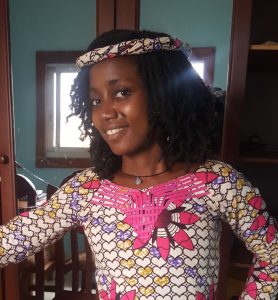 Béthune Pulchérie GOUNOU TEKOU obtained her MA in Linguistics at the Department of African Languages and Linguistics, University of Yaounde I, with a thesis entitled “Aspects of the lexical and phrasal phonology of Missong”, supervised by prof. Philip N. Mutaka. Pulchérie’s full CV.
Béthune Pulchérie GOUNOU TEKOU obtained her MA in Linguistics at the Department of African Languages and Linguistics, University of Yaounde I, with a thesis entitled “Aspects of the lexical and phrasal phonology of Missong”, supervised by prof. Philip N. Mutaka. Pulchérie’s full CV.
She has been part of the KPAAM-CAM team as a MA student and assistant in the process of preparing our huge database and extensive metadata for archiving.
Béthune Pulchérie GOUNOU TEKOU’s thesis summary
Aspects de la phonologie lexicale et syntagmatique du Missong
Missong is a Beboid language spoken in the North-west region of Cameroon. In fact, very few scientific works have been done in Missong, (Hombert (1980) and Lovegren (2013)). From the work of Lovegren, we entitle our research “Aspects of the lexical and phrasal phonology of Missong”. Our main objective was to analize sounds and tones in the lexical and phrasal levels. Many questions led our work: what constitute the sound system of Missong? How do tones in this language behave on the lexical and postlexical levels? For our investigations, we used a questionnaire of 1500 words (SIL Wordlist) and sentences built from collected words. During our research, we used two main approaches: structuralism and generative phonology. From our analyses we retain that Missong has 15 noun classes. Its sound system shows 49 (33 consonants and 16 vowels) and 33 phonemes (24 consonants and 9 vowels). Its underlying representation, shows: high tone words, sometimes low tone words, and toneless words. Otherwise, from our data, we concluded that, in addition to being a tone language, Missong highlights the stress as Munken and Biya (neighbour languages). Our study helped us to come out with many phonological processes such as: allomorphy and segmental circumscription.
Pulchérie’s thesis (in French) is available here.